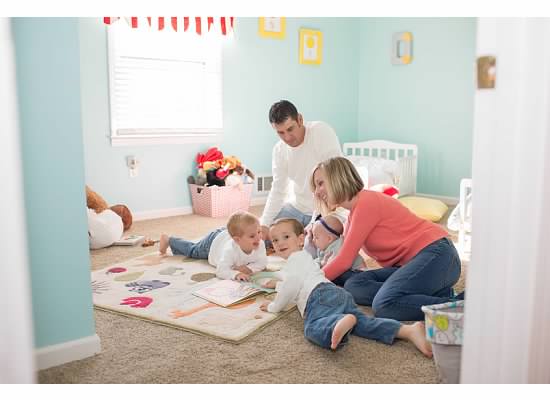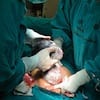This persistent mama wasn’t going to let a complicated cesarean birth with twins keep her from having “the birth experience of her dreams” with her 2nd pregnancy when she underwent vaginal birth after cesarean (VBAC).
After 6 years of trying to conceive, Georgia native Pam Lawrence didn’t think she and her husband Will were going to be parents—it seemed to be one negative pregnancy test after another. “They were the saddest negatives ever,” she says. “It felt like I was never going to see that second little line.” But Pam was not prepared to admit defeat: She sought out support from a local nonprofit that helps couples with in vitro fertilization (IVF), and shortly after, she got a big fat positive (pregnancy test).
“I couldn’t believe it. When the doctor called me back, I asked, ‘Ok, but just exactly how pregnant am I?’” she laughs. They reassured her she was “really pregnant”—the ultrasound confirmed twins!
Two complicated little lines
Pam’s pregnancy progressed smoothly until the end of her 2nd trimester, when she began experiencing what she thought were Braxton Hicks contractions. In reality, her cervix was starting to open prematurely and her doctor admitted her to the hospital on strict bed rest.
Nearing her 35th week of pregnancy, Pam was growing restless and wanted to return home for Will’s 30th birthday party. She was excited to celebrate with her husband, but at 5’6″ and 100 pounds pre-pregnancy, Pam was beginning to feel the full weight of carrying twins. “I was all puffy and swollen, and I started having blood pressure issues,” Pam explains. “At this point, I was so uncomfortable that I didn’t care if they pulled them out of my nose!” Soon after, she headed back to the hospital.
A few days after being readmitted, Pam woke up in the middle of the night to what she thought was her labor starting. “I assumed my water had broken,” she remembers. “But when the nurse came in to check on me, I was gushing blood.”
Pam’s placenta had separated from the uterus (placental abruption), and she was hemorrhaging. By the time the babies were born via emergency cesarean, Pam had lost 60% of her blood volume. Her quick-acting medical team was able to save Pam—and twins David and Jacob—from a potentially deadly outcome.
Second time’s a charm
Shortly after weaning the boys, Pam had a peculiar feeling. “I don’t know how to explain it,” she says, “other than I thought, ‘Dang, if I don’t feel pregnant!’ I think I honestly knew right then, before any test. But I took one anyway, and boom—there it was!”
As Pam began pondering how the next several months would progress, she knew this pregnancy would be different. “Not to detract from how precious David and Jacob are to me, but everything about their conception and entrance into the world was so medical and scientific,” she explains. “And I know that giving birth where I did undeniably saved my life. But after such a stressful birth experience, I just wanted to be treated like a normal person.”
After a few appointments with her previous provider, Pam didn’t feel like it was the right fit this time around. “I felt like I was being treated like a hazard, even though I wasn’t exhibiting any high-risk signs,” she says. “Pregnancy nowadays is so tampered with, and while a lot of women are afraid to speak up, I knew that this was not how I wanted my daughter to enter the world. There had to be another option.”
Finding her voice
At 12 weeks, Pam decided to find a new practice—one where she could have a vaginal birth after cesarean (VBAC). “My friend is a doula and was in school at the time to become a midwife,” Pam says. “She encouraged me to get familiar with doctors in the area who had experience with VBAC.”
With this vision of a calmer, more natural experience in her mind, Pam also began toying with the idea of an un-medicated birth; a video of a home water birth sealed the deal. “Here I was, pregnant and hormonal and watching this woman go through this, and I got really emotional,” she explains. “I knew that was what I wanted. I felt like it was a rite of passage, and I started to feel very empowered at that moment. This time, I was going to call the shots. It was very, ‘I am woman—hear me roar!’”
In the end, Pam chose a midwifery practice that worked in collaboration with a top perinatologist in Atlanta. “I knew there was a chance I might need a repeat cesarean,” she says. “This was one of the few places in the area that specialized in family-centered cesareans: I would be able to move my arms, the lights would be dimmed, and I would get to nurse immediately with my baby skin-to-skin as I was being stitched up.”
SEE ALSO: Cancer in new Moms; my story
Like night and day
Ultimately, her birthing experiences couldn’t have been more different. For example, Pam was able to go the full 40—and then some. “Labor with my daughter, Charlotte, was a very gradual process,” she says. “I woke up 40 weeks and 5 days pregnant and knew it was starting.”
After her mom picked up the twins, Pam was able to labor at home, spending time with her husband. “We went on walks to get things rolling, talking about what was about to happen, and then I laid down to get some rest—that’s when it kicked into high gear,” she says. The couple made the hour-long drive to Atlanta as her contractions grew stronger.
At the hospital, Pam was able to be up and move around during labor. “It was nice not being tethered to anything,” she says. “They gave me the option of getting in the shower if I wanted, and I spent some time using a birthing ball, too. And while the contractions were painful, it was great to let my body do its job.”
Pam pushed for several hours before it became obvious that Charlotte was a bit stubborn: “She was wedged up under my tailbone and sunny side-up,” she laughs. “Very true to the person she is today: strong-willed and tough as nails.” Her perinatologist was able to get Charlotte out safely—and Pam still achieved her goal of an un-medicated vaginal birth.
“I think if I had birthed with any other practice or in any other hospital, I would have ended up with a repeat cesarean,” she says. “But my care team was amazing, so knowledgeable and patient. They really listened to my wants and needs, and I think that finding a team you trust is key to being confident about your choices. Never hesitate to speak up about what you want.”
Related articles








Comments are closed.